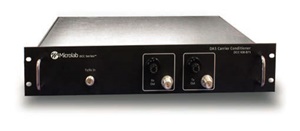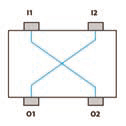DAS Applications
Abstract
Microlab offers a wide selection of wireless infrastructure products ranging from RF and microwave components for radio base-stations, to solutions for distributed antenna systems (DAS), in-building architecture, as well as wireless components for military and medical applications. Microlab’s RF components share unique capabilities in the area of broadband frequency coverage, combined with minimal loss and very low PIM.
Microlab offers: neutral host DAS and co-siting combiner solutions, hybrid couplers and hybrid matrices, attenuators, RF terminations, RF power splitter and diplexers, also known as cross band couplers, as well as RF signalconditioners and broadband combiner boxes for DAS deployments.
- DAS Distributed Antenna Systems
- SMARTTM Signal Conditioners
- SMARTTM Signal Combiner
- Passive Intermodulation (PIM)
- Components
Distributed Antenna Systems (DAS)With exploding wireless data use, network infrastructure, both in-building and outdoors, must offer adequate coverage and bandwidth to handle and transport this huge amount of data. According to a research carried out by Cisco, smart phones require 24 times the amount of data bandwidth of regular phones, and tablets are even more demanding. They require on average, 122 times more data compared to a regular phone. Future predictions draw a picture of triple digit data increases. To make the task even more daunting, use of data is becoming increasingly localized to areas with a high user density, many of them using multiple devices at the same time. Large office buildings, concentrated residential areas, public buildings like subway stations, airports, sport arenas or convention centers require infrastructure solutions that provide best efficiency, while at the same time resolving coverage and capacity challenges. Signals of different wireless operators with different frequencies have to be accommodated and re-distributed to provide best coverage without mutual interference. Public safety signals often share the same wireless infrastructure with commercial signals. Clearly, networks must guaranty sufficient bandwidth and interference-free operation for these services. Furthermore, in-building and outdoor infrastructure has to be scalable and open for emerging wireless networks and future technologies. |
|
To make the most of the benefits of coaxial DAS systems, it is very important to minimize loss at every stage and have the bandwidth to cover present and future needs. For economic reasons, both send and receive signals share the same cable. The system must be designed for the optimal Transmit and Receive levels at every antenna location. This requires very careful planning. A combination of equal and unequal signal splitters establishes the same path loss between base station and each antenna. Microlab’s components and infrastructure solutions are designed especially for these requirements. While the demand for wireless coverage and capacity is similar for in-building and outdoor users, the supporting infrastructure has to be designed especially for this location to offer optimized services. Cookie-cutter solutions are most certainly not the right approach. But how does this work with the economic constraints that are dominating every infrastructure investment? Microlab products offer low operational costs over the total lifetime of a system. Well designed Distributed Antenna Systems, both inbuilding and outdoors, provide high quality but costeffective coverage solutions for any given environment. They provide coverage in locations where (additional) cell site towers are simply not a viable option. With three or even four digit growth of data demand within the next five years, network operators must prepare their infrastructure to support this demand. And they have to offer highest QoS; new feature-rich smart phones alone do 
|
not guarantee low churn. Network infrastructure is the foundation of any wireless operation, only the right components and systems will satisfy the huge demand for reliable communications inside office, public and residential buildings.  The wireless world is very dynamic. Flexible, but high quality of components and systems are expected and the supporting economics have to be sound, but as also important is the availability of systems and components when and where they are needed. Delays are seldom acceptable and just in-time/off-the-shelf delivery can decide the failure or success of a project. Microlab delivers most components from off-the-shelf.
Microlab products are well known and accepted throughout the market. As the right partner for high performance wireless network infrastructure and economic, high quality components, or in-building and outdoor DCC Series® DAS Carrier Conditioners, Microlab delivers. |
DCC Series® DAS Carrier ConditionersWireless operators utilize different receiving and transmitting bands. For economic reasons, it is desired to combine these signals in DAS systems. Fiber systems convert RF signals into light pulses, which are converted back to RF at the areas where RF is needed. Here it is distributed via a variety of antennas, to ensure optimal wireless coverage. |

Multi-Signal DCC Series® DAS Carrier Conditioners Microlab custom designs boxes that conveniently integrate passive components. A common example is the DCC Series® DAS Carrier Conditioners used at the Point of Interface between service providers and an in-building or outdoor Distributed Antenna System (DAS). Requirements commonly include the need to combine commercial signals with public service channels or Tetra. Frequency ranges are usually 380 to 520 MHz with cellular services extending from LTE 700 to WiMAX / LTE-2600, as well as other services up to 6 GHz. Microlab’s broad range of catalog diplexers and hybrids allow rapid creation of special configurations to suit customer needs, whether for in-building, trains, tunnels, or applications is hospitals. To simplify requirements further, Microlab also offers standard designs which offer for example 4 low band and 4 high band inputs combined to 4 identical outputs, which may be distributed to different parts of an in-building project. |
|
|
|
|
|
|
Passive Intermodulation (PIM)Wireless high speed data networks with their tightly grouped, high frequency signals and complex modulation schemes, associated with high sensitivity receivers may face unanticipated but serious PIM (Passive Intermodulation) problems. Intermodulation can occur whenever more than one signal is present in an RF system and components display unwanted non-linear frequency responses. With non-linear components in the RF path, they act like mixers, modulators and frequency multipliers creating unwanted spurious products.
|
PIM (Passive Intermodulation distortion) Why is it critical to eliminate PIM? |
|
What causes PIM effects?
|
|
|
|
|
SYMBOL |
FEATURES |
IMAGE |
|
ATTENUATORS
|
||
|
||
|
||
|
||
|
||
|
||
|
DCC SERIES® DAS CARRIER CONDITIONERS
|
||
|
||
|
||
|
||
|
||
|
||
|
||
















